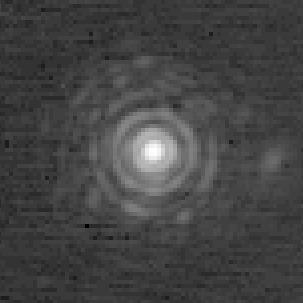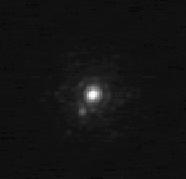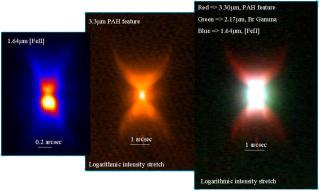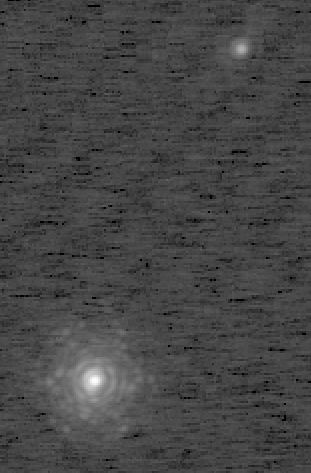29 January 2003, updated 3 March 2003
Summary:
Altair arrived at Gemini on October 14, 2002. It went through two commissioning runs in November and December, and commissioning is proceeding well. A number of problems were encountered; most of them have been identified and fixed, or are in the process of being fixed. Strehl ratios of up to 55% with FWHM of 61mas were obtained in K band in the best conditions. The next commissioning runs are planned for April and May.
Details:
Altair arrived at Gemini on October 14, 2002. The team worked on it in the lab at the summit until November 5, at which date it was mounted on the telescope. Everything was basically ready for the first night. We first closed the loop around 11:00PM that night, blessed by very decent seeing (around 0.5"), and got a Strehl of 21% in H band for a FWHM of 65mas. After a quick celebration, the team proceeded with commissioning activities: establishing coordinate systems, communications between Altair and various telescope systems, sequence executor work, and the many calibrations required to make such a complex facility system work. The main limitation encountered during the first run was that the system had difficulties keeping a stable loop for seeing worse than about 0.6". This was traced back to two main causes:
- too small a pixel size in the wavefront sensor (0.32"/pixel, 2x2 pixels/subaperture)
- too large a field stop at the WFS input (the mechanism was stuck at the largest size available, 3").
This was fixed in between the two runs by switching to a binned mode on the wavefront sensor CCD, resulting in 0.64"/pixels. The field stop mechanism was also fixed, but the new stage could only be implemented close to the end of the second run, providing only a couple of nights of testing. These changes provided much better stability of the loop and better tolerance for average to moderately bad seeing conditions (up to about 0.9").
We also encountered a problem with elongated images on NIRI that was eventually traced to the Acquisition & Guiding Science Fold mirror oscillating by 35mas rms about its ideal position. This was fixed by changing the servo parameters of this mirror's mechanism.
All the offloading loops to the secondary and primary mirrors are now working. The sequence executer integration is well underway and the "seq exec" software can execute simple sequences, coordinating NIRI exposures, changing filters, stopping and resuming the AO loop and dithering. The throughput of the Altair science path was measured to be quite high (89% in H band, including all Altair surface and the science fold). Emissivity has not yet been measured. The loop was closed on star up to R=13 with good results. We have not tried yet to probe the limiting magnitude of the system.
Finally, and although this relies only on a small sample which is not yet statistically significant, one area of concern is the anisoplanaticity. The conjugation of the deformable mirror to 6.5km was implemented because it was believed this would increase the isoplanatic angle [the main turbulence layer was thought to be at 6.5km]. It turns out that in the stellar field images obtained to date, the isoplanatic angle seems smaller than on other (i.e. "ground-conjugated") AO systems. We have not yet compiled an exhaustive database of performance yet, so this statement should be taken with caution. If this is confirmed in the next runs, we will put in place an upgrade path that will reduce the impact of this problem.
Some images:
 |
Left: Log intensity display of the Br Gamma image of the 10 micron light source in Altair, as seen by NIRI. The Strehl ratio is 87%, the Full Width at Half Maximum around 61mas. The field of view is 1.6"x1.6". This image was taken after we optimized the non-common path aberrations with NIRI, so many rings are visible and they are complete (i.e. unbroken) for the most part. The first and third rings are prominent. The second ring is almost absent, due to the shape of the entrance aperture (ratio between the central obstruction and the outer pupil diameter). Note: this image was wrongly referred to as an image of a star in previous version of this web page. |
 |
Left: Log intensity display of an anonymous double star with 0.25" separation. Wavelength: Br Gamma. Strehl = 62%, FWHM = 69mas. Click on the image to get a larger version. |
Last update March 3, 2003; Francois Rigaut.


